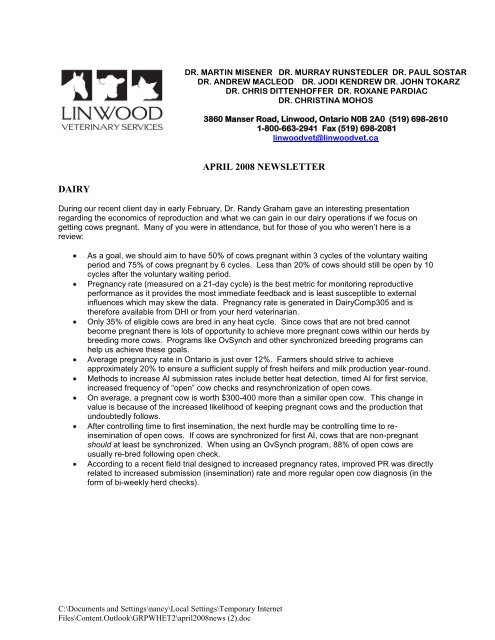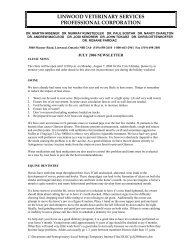METZGER VETERINARY SERVICES - Linwood Veterinary Services
METZGER VETERINARY SERVICES - Linwood Veterinary Services
METZGER VETERINARY SERVICES - Linwood Veterinary Services
You also want an ePaper? Increase the reach of your titles
YUMPU automatically turns print PDFs into web optimized ePapers that Google loves.
DAIRY<br />
C:\Documents and Settings\nancy\Local Settings\Temporary Internet<br />
Files\Content.Outlook\GRPWHET2\april2008news (2).doc<br />
DR. MARTIN MISENER DR. MURRAY RUNSTEDLER DR. PAUL SOSTAR<br />
DR. ANDREW MACLEOD DR. JODI KENDREW DR. JOHN TOKARZ<br />
DR. CHRIS DITTENHOFFER DR. ROXANE PARDIAC<br />
DR. CHRISTINA MOHOS<br />
3860 Manser Road, <strong>Linwood</strong>, Ontario N0B 2A0 (519) 698-2610<br />
1-800-663-2941 Fax (519) 698-2081<br />
linwoodvet@linwoodvet.ca<br />
APRIL 2008 NEWSLETTER<br />
During our recent client day in early February, Dr. Randy Graham gave an interesting presentation<br />
regarding the economics of reproduction and what we can gain in our dairy operations if we focus on<br />
getting cows pregnant. Many of you were in attendance, but for those of you who weren’t here is a<br />
review:<br />
As a goal, we should aim to have 50% of cows pregnant within 3 cycles of the voluntary waiting<br />
period and 75% of cows pregnant by 6 cycles. Less than 20% of cows should still be open by 10<br />
cycles after the voluntary waiting period.<br />
Pregnancy rate (measured on a 21-day cycle) is the best metric for monitoring reproductive<br />
performance as it provides the most immediate feedback and is least susceptible to external<br />
influences which may skew the data. Pregnancy rate is generated in DairyComp305 and is<br />
therefore available from DHI or from your herd veterinarian.<br />
Only 35% of eligible cows are bred in any heat cycle. Since cows that are not bred cannot<br />
become pregnant there is lots of opportunity to achieve more pregnant cows within our herds by<br />
breeding more cows. Programs like OvSynch and other synchronized breeding programs can<br />
help us achieve these goals.<br />
Average pregnancy rate in Ontario is just over 12%. Farmers should strive to achieve<br />
approximately 20% to ensure a sufficient supply of fresh heifers and milk production year-round.<br />
Methods to increase AI submission rates include better heat detection, timed AI for first service,<br />
increased frequency of “open” cow checks and resynchronization of open cows.<br />
On average, a pregnant cow is worth $300-400 more than a similar open cow. This change in<br />
value is because of the increased likelihood of keeping pregnant cows and the production that<br />
undoubtedly follows.<br />
After controlling time to first insemination, the next hurdle may be controlling time to reinsemination<br />
of open cows. If cows are synchronized for first AI, cows that are non-pregnant<br />
should at least be synchronized. When using an OvSynch program, 88% of open cows are<br />
usually re-bred following open check.<br />
According to a recent field trial designed to increased pregnancy rates, improved PR was directly<br />
related to increased submission (insemination) rate and more regular open cow diagnosis (in the<br />
form of bi-weekly herd checks).
EQUINE<br />
Equine Choke<br />
The term choke in equine medicine does not refer to a blocked airway but rather a blockage of<br />
the esophagus. The esophagus is approximately 4 feet in length and it connects the throat to the<br />
stomach. It is a very muscular structure and these muscular contractions allow the feedstuff to travel into<br />
the stomach. A blockage generally occurs when a foreign body is swallowed or if a wad of food is not<br />
chewed properly and an inadequate amount of saliva is present.<br />
The majority of equine chokes are mild, unnoticed and are resolved spontaneously once enough<br />
saliva has travelled down into the esophagus. However, there are some incidences that require medical<br />
intervention to help clear the blockage or remove the foreign body. Equine choke is rarely a life<br />
threatening issue but if the blockage is significantly large, it can cause long term damage to the<br />
esophageal tissues leading to chronic issues.<br />
Even though the majority of equine chokes do resolve on their own without complications, there<br />
are certain factors that help indicate if this case requires emergency care. If the horse is stressed and<br />
appears to be agitated, or if there is saliva or feedstuff coming out of one or both nostrils, emergency<br />
veterinary assistance is required and you should contact your veterinarian immediately. While awaiting<br />
the veterinarian’s arrival, please remove all feed and water from the horse’s stall and try to keep them as<br />
calm as possible.<br />
Certain types of feed are known to cause an increase chance of your horse developing choke.<br />
Dried, pelleted beet pulp is more likely to cause choke because once the dried beet pulp comes into<br />
contact with saliva, it can expand to 4 times its original size. In order to avoid a case of choke, the<br />
pelleted beet pulp should be soaked and allowed to expand prior to being fed. Pellet size has also been<br />
showed to potentially cause an episode of choke. Smaller pellets are often inadequately chewed and not<br />
enough saliva gets added to the feedstuff making it more difficult to swallow. If your horse tends to bolt<br />
his small pellets, you may want to attempt to slow him down by adding large rocks to his feed tub thereby<br />
making him push them around in order to attain his feed.<br />
Prevention is always the best medicine. Avoid feeding dried pelleted beet pulp and ensure your<br />
horse does not rapidly consume his small pelleted feed. If carrots and apples are fed, make sure to offer<br />
them in small bit size pieces. If you are at all concerned that your horse is suffering from a case of equine<br />
choke and appears to be agitated or saliva/feedstuff is present in his nostrils, please contact your<br />
veterinarian immediately.<br />
C:\Documents and Settings\nancy\Local Settings\Temporary Internet<br />
Files\Content.Outlook\GRPWHET2\april2008news (2).doc



